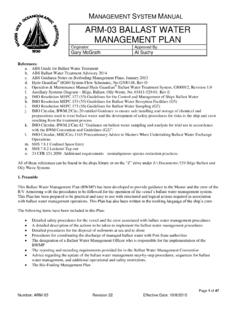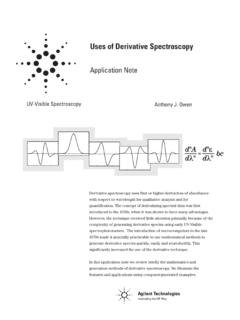Transcription of Lagrangian and Eulerian Representations of Fluid Flow ...
1 Lagrangian and Eulerian Representations of Fluid Flow: Kinematics and the Equations of Motion James F. Price Woods Hole Oceanographic Institution, Woods Hole, MA, 02543. June 7, 2006. Summary: This essay introduces the two methods that are widely used to observe and analyze Fluid flows, either by observing the trajectories of specific Fluid parcels, which yields what is commonly termed a Lagrangian representation , or by observing the Fluid velocity at fixed positions, which yields an Eulerian representation . Lagrangian methods are often the most efficient way to sample a Fluid flow and the physical conservation laws are inherently Lagrangian since they apply to moving Fluid volumes rather than to the Fluid that happens to be present at some fixed point in space.
2 Nevertheless, the Lagrangian equations of motion applied to a three-dimensional continuum are quite difficult in most applications, and thus almost all of the theory (forward calculation) in Fluid mechanics is developed within the Eulerian system. Lagrangian and Eulerian concepts and methods are thus used side-by-side in many investigations, and the premise of this essay is that an understanding of both systems and the relationships between them can help form the framework for a study of Fluid mechanics. 1. The transformation of the conservation laws from a Lagrangian to an Eulerian system can be envisaged in three steps.
3 (1) The first is dubbed the Fundamental Principle of Kinematics; the Fluid velocity at a given time and fixed position (the Eulerian velocity) is equal to the velocity of the Fluid parcel (the Lagrangian velocity) that is present at that position at that instant. Thus while we often speak of Lagrangian velocity or Eulerian velocity, it is important to keep in mind that these are merely (but significantly) different ways to represent a given Fluid flow. (2) A similar relation holds for time derivatives of Fluid properties: the time rate of change observed on a specific Fluid parcel, D.
4 /=Dt D /=@t in the Lagrangian system, has a counterpart in the Eulerian system, D. /=Dt D /=@t C V r. /, called the material derivative. The material derivative at a given position is equal to the Lagrangian time rate of change of the parcel present at that position. (3) The physical conservation laws apply to extensive quantities, , the mass or the momentum of a specific Fluid volume. The time derivative of an integral over a moving Fluid volume (a Lagrangian quantity) can be transformed into the equivalent Eulerian conservation law for the corresponding intensive quantity, , mass density or momentum density, by means of the Reynolds Transport Theorem (Section ).
5 Once an Eulerian velocity field has been observed or calculated, it is then more or less straightforward to compute parcel trajectories, a Lagrangian property, which are often of great practical interest. An interesting complication arises when time-averaging of the Eulerian velocity is either required or results from the observation method. In that event, the FPK does not apply. If the high frequency motion that is filtered out is wavelike, then the difference between the Lagrangian and Eulerian velocities may be understood as Stokes drift, a correlation between parcel displacement and the spatial gradient of the Eulerian velocity.
6 In an Eulerian system the local effect of transport by the Fluid flow is represented by the advective rate of change, V r. /, the product of an unknown velocity and the first partial derivative of an unknown field variable. This nonlinearity leads to much of the interesting and most of the challenging phenomena of Fluid flows. We can begin to put some useful bounds upon what advection alone can do. For variables that can be written in conservation form, , mass and momentum, advection alone can not be a net source or sink when integrated over a closed or infinite domain. Advection represents the transport of Fluid properties at a definite rate and direction, that of the Fluid velocity, so that parcel trajectories are the characteristics of the advection equation.
7 Advection by a nonuniform velocity may cause linear and shear deformation (rate) of a Fluid parcel, and it may also cause a Fluid parcel to rotate. This Fluid rotation rate, often called vorticity follows a particularly simple and useful conservation law. Cover page graphic: SOFAR float trajectories (green worms) and horizontal velocity measured by a current meter (black vector) during the Local Dynamics Experiment conducted in the Sargasso Sea. Click on the figure to start an animation. The float trajectories are five-day segments, and the current vector is scaled similarly. The northeast to southwest oscillation seen here appears to be a (short) barotropic Rossby wave; see Price, J.
8 F. and H. T. Rossby, Observations of a barotropic planetary wave in the western North Atlantic', J. Marine Res., 40, 543-558, 1982. An analysis of the potential vorticity balance of this motion is in Section 7. These data and much more are available online from and other animations of float data North Atlantic are at lukeman/projects/argo/. 2. Preface: This essay grew out of my experience teaching Fluid mechanics to the incoming graduate students of the MIT/WHOI Joint Program in Oceanography. Students enter the Joint Program with a wide range of experience in physics, mathematics and Fluid mechanics.
9 The goal of this introductory course is to help each of them master some of the fundamental concepts and tools that will be the essential foundation for their research in oceanic and atmospheric science. There are a number of modern, comprehensive textbooks on Fluid mechanics that serve this kind of course very well. However, I felt that there were three important topics that could benefit from greater depth than a comprehensive text can afford; these were (1) dimensional analysis, (2) the Coriolis force, and (3). Lagrangian and Eulerian Representations of kinematics. This is undoubtedly a highly subjective appraisal.
10 What is clear and sufficient for one student (or instructor) may not suit another having a different background or level of interest. Fluid mechanics has to be taken in bite-sized pieces, topics, but I also had the uneasy feeling that this Fluid mechanics course might have seemed to the students to be little more than a collection of applied mathematics and physics topics having no clear, unifying theme. With that as the motive and backdrop, I set out to write three essays dealing with each topic in turn and with the hope of providing a clear and accessible written source (combined with numerical problems and software, where possible) for introductory-level graduate students.









